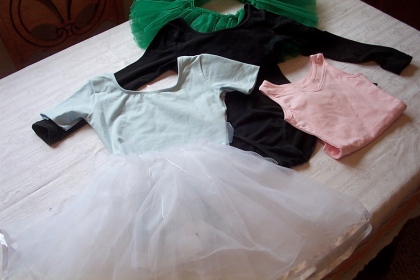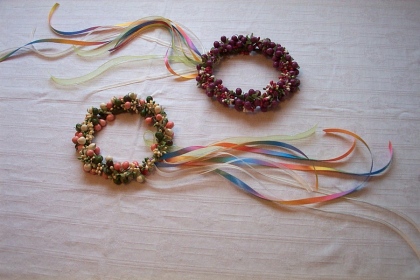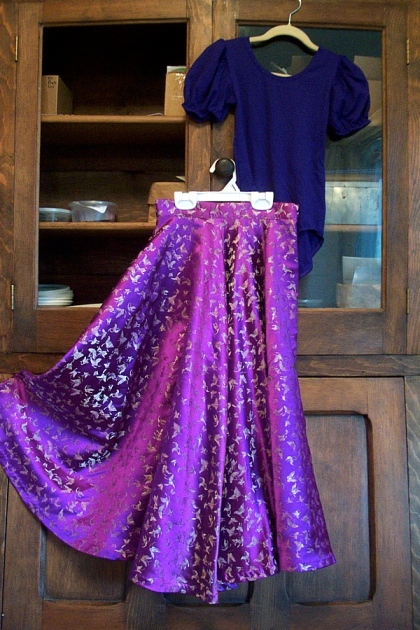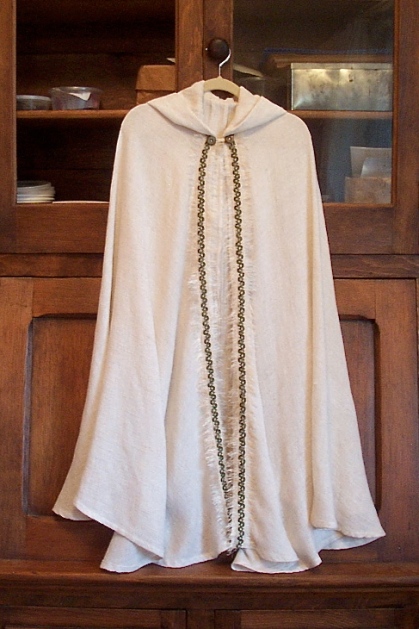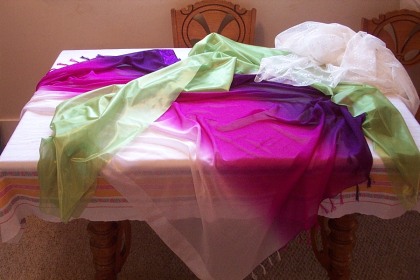Tour of the Costume Box: Ball Gown
October 25, 2011
Halloween Countdown: 6 days
First I drew up a pattern for a very full bell-shaped gored skirt and sewed it in blue-grey taffeta. Then I fashioned the overskirt from some geriatric ruffled nylon curtains (Goodwill). A piece of coordinating sheer polyester yardage, hemmed on the raw edges, makes a sparkly night-sky wrap. The skirts are worn over a crinoline and a light blue leotard.
I had some material to work up into a bow or a rosette for the center of the waist, but I forgot about it until the day I was packing the box, so it didn’t happen. Here’s the back of the overskirt. You can see how it’s a bit poufier than the front because of the way the curtains were made.
Tour of the Costume Box: Poor Cinderella
October 24, 2011
Halloween Countdown: 7 days
Time and again I’ve noticed little girls’ dramatic obsessions with beggar girls; with ragged, shivering orphans; with ill-used maids-of-all-work.
Authors come by it honestly, I guess.
Feeling the need to allow my nieces to allow themselves to feel wretched and abused, I made this:
Two layers of gauze, attached to an overskirt with an asymmetrically bias-dagged hemline. First I bleached cheesecloth (it was red-orange) just the way you’re not supposed to do, in order to achieve the mottled, faded results that would usually mean you had ruined your laundry. The gauze was left pretty ragged by this treatment, but I helped it along to achieve truly Cinderella-y tatters.
To be worn with the eBay-purchased peasant top on the left or, for the purist, sackcloth and ashes.
It’s no good going to the ball if you don’t get to suffer for it first!
Tour of the Costume Box: Tulle and Humbler Garments
October 23, 2011
Halloween Countdown: 8 days
This is me, but I think used nylon leotards are kind of nasty. I have no objection to used tutus, but where does one find such a thing? I surely wasn’t going to spend months of my life pulling gathers into yards of tulle and stitching them to elastic bands, so I sprung (I use the term liberally), for some new tutus and leotards on eBay. Leotards are important for the whole mix-and-match concept. Most of the garments I made were intended to be at least semi-un-out-grow-able, which means they were skirts.
Tutus. The more the better! If I had been the recipient of this box I would have been thinking snow fairy for the white one, and a plant fairy of some kind for the green. Stay tuned for more tutus and fairy gear this week. The problem with tutus and filmy fabrics in general is what to wear underneath. Sometimes a leotard won’t do. A selection of the humbler garments:
I think of aprons as humble. I sewed this one because I had an eyelet remnant and thought, that would make a tiny apron. It was one of those easy projects that turn out to be surprisingly time-consuming, what with the interfacing and hand hemming and basically figuring out how to make the thing. So here’s what’s funny: according to my sister, among all the glitter, my kindergarten-aged niece homed right in on the apron. To her, an apron is exotic–the perfect accessory for any number of olde-tymey characters. I’m glad I didn’t waste my time on it!
A bright fringy shawl is, of course, a peasant staple.
Tour of the Costume Box: Swords and Garlands
October 22, 2011
Halloween Countdown: 9 days
Are you working on your costume, yet? No? Putting it off until next weekend and reading blogs instead?
These are so my nieces can pretend to be flower fairies. Or knights. Or flower fairies with swords. Or knights in beribboned headgear.
The wooden swords kept breaking in the mail or arriving otherwise defective, but the eBay seller just kept sending replacements until I had two good ones. One sword for two litte girls: not a good idea.
I found the wreathes (of sprays of plaster globules) in what I call the Candle Crap aisle at Goodwill, which makes me think it was originally meant to go around candles. They were falling apart, so I reshaped them and wound them with florist’s tape to cover the ends of the wires, and attached some trailing ribbons.
A headdress alone does not a flower fairy make. It will take me few more days to go through the fairy stuff.
Tour of the Costume Box: Booty and the Butterfly Skirt
October 21, 2011
Halloween Countdown: 10 days
Goodwill bonanza!
- A little girl’s floor-length gored purple satin brocade butterfly skirt home sewn by someone other than me! I replaced the button on the waistband, that’s it. It’s hanging with the first of several new leotards I bought on eBay: purple with puffed sleeves. I like to imagine the fabric store scenarios that go into the making of a skirt of this type.
“What kind of a skirt do you want Grandma to sew for you, sweetie?”
“A purple one.”
“Something like this?”
“No, a LONG skirt. A twirly skirt.”
“Here’s some purple fabric.”
“Not like that, it’s not shiny. I like this one.”
- A lined, valise-shaped basket perfect for storing hats (of which more later) or being a Victorian traveler.
- A velvet jewelry box. I whacked the dust out of it, de-linted it, aired it, and gave it sponge bath. Good as new.
- A child-sized basket suitable for Red Riding Hood but preferable for royal picnics. The peculiarly child-sized metal goblet has lost most of its silver plate but still shines up nicely–perhaps it is a picnic for royals down on their luck. Their minions can drink from the depression-glass eggcups.
My luck ended with the eggcups. The sparkles and the many strands of beads are from a couple of costume jewelry lots on Etsy. They were dirty, I cleaned them bead-by-bead and brilliant-by-brilliant with soapy water and a boar-bristle brush. Some really good ones you can’t see, sorry! I was so sick of handling them by the time I packed them into the jewelry box, I didn’t want to unpack them for the picture.
Have you noticed how the costume jewelry at Salvation Army and Goodwill is overpriced and not very nice? Or is that just my Salvation Army and Goodwill? Salvation Army is particularly tricksy. They ram piles of costume jewelry down into old glass vases and jars, plaster the tops with packing tape, and sell them for $20 to $40! I think they are just teasing compulsive gamblers with the idea there will something good in the part of the jar you can’t see. When you know they tag anything interesting separately for their jewelry counter, and when everything you can see from the sides of the jar is pretty much just unmatched 1990’s plastic earrings and Mardi Gras beads, does it make sense to expect better in the middle?
Tour of the Costume Box: The Well-Dressed Peasant
October 20, 2011
Halloween Countdown: 11 days
I loved this fabric. The ground is a heavy, rustling matte black synthetic of some sort. I want to say taffeta, but it’s heavier than any taffeta I’ve seen. The pattern is picked out in satiny warp-overshot. I loved this fabric so much I bought it from St. Vincent de Paul when I was in my teens in the form of a full, gathered skirt on a wide waistband that was really too small for me. I loved it so much, I picked the skirt apart and made it into curtains for the first house Der Mann and I rented after we were married. I loved it so much, I took those curtains out of a box (we’ve moved a lot; I’ve learned to save curtains) and turned them into an elastic waist skirt for my nieces using the former curtain-rod casing as a hem.
Pictured here with the popular square-dance crinoline:
The coordinating size small ladies’ cotton top with decorative chain-stitching comes from Goodwill. With the the sleeves hemmed up five inches, it makes a roomy tunic for the well-dressed peasant child.
Tour of the Costume Box: Viking Girl Outfit
October 19, 2011
Halloween Countdown: 12 Days
I don’t know when I started thinking of this as the Viking Girl Outfit. It doesn’t have to be for a Viking, doesn’t have to be for a girl, and doesn’t even have to be worn as an outfit.
The trim is some discontinued green gimp. The fabric is a crammed-and-spaced plain weave from the 1970’s, handed down from I-can’t-remember-who in my family. I thought it was cotton, and I thought I’d washed it before storing it–but I was wrong. When I washed the finished garments they shed buckets of lint. The fabric was revealed as cotton-linen blend with some scratchy bits of flax-stem sticking out here and there.
Fortunately, no Viking Girl would cringe from the assaults of plant matter.
Both the cape and tunic are cut from a multipurpose children’s costume pattern purchased on Etsy: Simplicity 8004, circa 1992. When it arrived in the mail I discovered something very odd. There were no sewing instructions. Glueing, yes. Sewing, no.
Simplicity was plugging a product called Heat-n-Bond. They wanted you to make the costumes from lightweight fabrics that required no hemming, and they wanted you to iron them together whenever possible–lapping edges and using nice fat rolls of wonderful 3/8” Heat-n-Bond. This meant some of the printed seam allowances were wrong for sewn seams. Hem allowances weren’t factored in.
I traced and redrew. The cape is basically a 3/4 circle. On the positive side, 3/4 of a circle makes a full, twirl-able cape. On the negative side, there is no way to add length and still fit the pattern pieces on a 50-some-inch width of fabric. I sketched an ovoid instead. The hood is enormous! Simplicity drafted it with fiddly pleats to fit it to the neckline. I didn’t feel up to altering the hood’s basic shape, but I did want to line it. I cut out two complete hoods, pleated them individually, then sewed them together at the front–first interfacing the bejesus out of that front part with Craft-Fuse so it would not simply flop over my nieces’ heads like a sack.
Kind of Obi-Wan Kenobi, don’t you think?
Halloween Countdown: 13 days
You will have to trust me that this Chinese silk satin brocade cheongsam (eBay) is prettier than it looks in the picture and will exactly fit my older niece. The only flaw was a ballpoint pen line on the front which came came out with rubbing alcohol and blotting.
And try to believe me when I tell you this silk kimono-robe handed down from a college housemate is a worthy addition to The Box. It appears I myself only wear robes to keep warm–which could explain why this one sat in my drawer for 14 years. Or maybe I kept it because it reminded me of another silk robe about the same size and weight in my granny’s costume box; it did duty for a lot of different outfits.
Big pieces of drapey fabric are also fun. I think the shiny green polyester was meant to be a window treatment. Honestly, the crap people will put on their windows! The rejected house-goods they will dangle themselves over the sides of the “As Is” bins at IKEA for! Have they no shame?
Moving right along. . .
A wrap from Goodwill that feels like silk but isn’t. Do you see those big bands of color blending from white to magenta to purple? Does anyone know the name for this type of dyeing?–I’ve always wondered. Anyway, it’s luscious, but after getting it home and running it through the delicate cycle I discovered numerous pink candle wax stains! Fortunately, I got them out (mostly) by ironing them between paper towels and spot-cleaning with detergent. Unfortunately, after washing the wrap a second time I found tropical punch stains. There is such a thing as too much fun for grownups.
Last and least, a homemade lace curtain, also from Goodwill. I bleached it, picked out the stitching, cut off the ragged edges. I thought the pattern was kind of classy for nylon lace.
Tour of the Costume Box: Scarves and Other Lady Things
October 17, 2011
Halloween Countdown: 14 days
My dearest granny, who didn’t so much teach me to sew as model it in such a way that I osmosed it, believes she once had a Completely Original Thought. When she tells the story of her Completely Original Thought, I must hold my tongue instead of saying that I don’t think there is any such thing, and why do you care so much anyway, Gran?–because that is not the point. The point, the moral, the ironic twist (once she has fully conveyed the grandeur of her Completely Original Thought) . . . is that Granny can’t be SURE she had a Completely Original Thought because on the way to write it down she forgot it.
Next she tells the story of her Really Important Thought About Everything–though not so important as the Completely Original one–the gist of which she can repeat, but which doesn’t convey its full profundity:
“Scale doesn’t matter.”
I am here with Goldilocks to say otherwise.
Surely we can all agree that in a world scaled to humanoid bears, some things are too big for us? Others, weirdly, may be too small. Some are just right, but only by accident–which isn’t at all the same thing as being just right on purpose. I know my granny wasn’t talking about chairs or porridge bowls or purses; my point is that scale always matters when you forced to live on someone else’s scale instead of your own, which is what children do, and which is probably why they like the story of Goldilocks and the Three Bears. I think it also explains their fascination with the miniature. I know it explains mine.
What you want to notice in this picture is the small bamboo and silk fan with a gold case (eBay), and that the small beaded satin evening bag (Goodwill) constructed in exactly the same manner as what would have been a much larger handbag in the 1950’s–perfectly scaled for a six-year-old!
Though of less interest, I will also tell that you that the dainty antique linen handkerchief trimmed with net lace is one of many to come to me from my great-grandmother–I am less attached to the ones like too small to blow my nose on. And I must have bought these stretchy ivory gloves at St. Vincent De Paul when I was fifteen. Am I right that these are the sorts of ladylike things you would keep in your 1950’s handbag?
While we’re on the subject, I’ll just toss this shawl out on the table.
What do you think? Fringy black lace shawls–ladylike or floozie-eqsue?
Never mind. Into the box it goes. Now here are some scarves, so pretty! Let me tell you how I got them.
Some vendor at the antique mall bought up all the clothes at an estate sale. It was easy to see that everything in the stall had belonged to the same woman and that she had loved her clothes and had good taste and plenty of money all her life. The ranks of immaculate gowns and tailored suits and coats went from the 1930’s through the 1960’s, and there were scarves and hats and gloves in staggering quantity as well. I wish I had bought more scarves; they were marvelous and they were cheap, cheap, cheap! Most of the ones here were made in Japan: three of those those crinkly sheer nylon squares everyone used to wear to protect their hair-dos, a long flame-red scarf of silk/poly georgette, slithery lightweight black silk crepe, and my favorite: an incredibly fine black silk with silhouettes of rose leaves. Yesterday I walked by the same antique mall and saw that it had gone out of business. Darn.
The textured yellow silk scarf with a print of playing Japanese girls was from Goodwill, however, not the good lady who so thoughtfully declined to be buried with her wardrobe.
Tour of the Costume Box: General Notes and a Queeny Wizard
October 16, 2011
Halloween Countdown: 15 days
About half a year ago I realized my nieces are just the age when playing pretend is most exciting. This reminded me of how when I was their age, the very best pretend-play would sometimes turn electric. It happened often when I could not only “be” whatever I was “being,” but wear their clothes! I decided to make the girls a costume box.
The costume box of my youth was (is) a black tin trunk in my granny’s (the live one’s) basement filled with leftovers from my mother’s and aunts’ dress-up days. Granny understands dress-up. At nine she fashioned Barsoom costumes for herself and her friends from scraps of lamé and satin; they spent that whole summer running around each other’s yards pretending to be Edgar Rice Bourroughs’ Martians. All through Granny’s childhood and teens, in fact, whenever she wasn’t sewing clothes and costumes for her dolls, she was sewing them for herself. The Halloween costumes she made for my mother and aunts involved a yearly ritual of sewing, repurposing, and papier-mâché-ing on a par with Easter dresses for importance. Later, when my aunts were teenagers and didn’t care, Granny gave away most of their old costumes and other dress-up things to a mother of young children who was going through a divorce–a gift the woman ever after credited with saving her sanity. I liked to imagine what might have been in that Box Of Yore. It must have been amazing considering what was left.
The tin trunk was (is) not big. There were not a lot of clothes in it, but what there were stood out in magnetic strangeness by way of their antiquity. In Granny’s costume trunk I found weights, weaves, fibers, and methods of decoration I understood had used to be part of people’s normal lives, but which I had never seen or handled in my own. The first fabrics I loved were costumes.
Are you curious? Well, there was my great-grandmother’s sheer Spanish shawl from the 1920’s, covered in satin-stitch peonies. There was the embroidered silk dragon robe sent from China by Granny’s brother in the service, and the impossibly skinny blue-green moire 1950’s cocktail gown with a fishtail flounce, donated by the Cruella DeVille-like “Mean Aunt N___” who terrified my aunts as children. There was the beautiful Japanese fan still in its disintegrating pre-war presentation box, the Moroccan finger-cymbals, the faux-Edwardian Mary Poppins dress with contrasting-lined bias-cut frills and shiny black buttons up the front. My favorite as a small child was a Mexican peasant dress with different colors of rickrack going round and round–twirly! Sadly, the rustling Renaissance “princess dress” of highly polished blue cotton was too big until I was quite old and then quickly outgrew it. Its skirt was interlined with a stiffening buckram-like stuff, the lining was rose organdy, the sleeves trailed to the knee, and the square neckline was trimmed with perfect wee daisies–so typical of Granny’s loving attention to detail.
That is just a sample.
I could not and would not wish to duplicate the costume box of my youth. Like Granny, I love attention to detail in garment construction; unlike her, I do not love to sew and would never have the patience to interline a princess dress. Another issue is utility. Granny’s costumes were too old and special to wear while tearing around outdoors, but tearing around outdoors is (I always found) a prerequisite for really good pretend-play. I wanted my nieces to have costumes they could play with anywhere, anytime; yet which still had incorprated the variety of fabrics and real-garment quality of construction that made my Granny’s costumes so magical.
The best outfits for pretend play are ones with mixable pieces, so my other goal was to give the girls lot of components that lent themselves to being draped and tied and swapped out, as well as a few good base garments that fit them. (Nothing is more frustrating than something pretty you can’t wear because it’s too big and looks all wrong and dumpy on you!) Most of all, I wanted them to light up with a sense of dramatic possibility the way I would have done if someone had given me a big box of purpose-gathered costumes when I was their age.
So then I sewed and thrift-stored and laundered and mended for longer than I like to admit. Now that all 26 pounds of costumes are in UPS truck speeding to my nieces, I will share them with you.
Starting with . . .
The Queeny Wizardy Robe
This fabric, which you can’t see properly, is a cross-dyed polyester taffeta that shines black one way and wine red the other. It came from a set of curtains in a clearance pile at a discount store; I thought the taffeta would be perfect for a wicked queen or wizard. The matching valance made up into a pointy princess hat which you will see at a later date.
To cut this thing out I combined different views from Period Patterns No. 16: “Tunics, c. 650-1310 A.D.”–redrawing the pointed sleeves to be shorter, unlined, and more bell-like for lack of fabric. I refused to set-in the sleeves the way the pattern directions directed. Sewing the sleeves to the body and then sewing the underarms and side seams in one go with a clipped, reinforced curve worked just fine, so nyah!
Here you can see it with a big piece of iridescent chiffon I squared up and hand-hemmed along the raw edges for a Queen of the Night veil.



